Silk
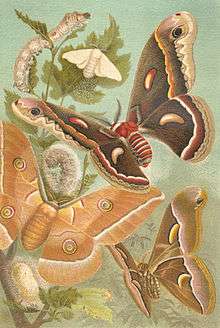
Bombyx mori, Hyalophora cecropia, Antheraea pernyi, Samia cynthia.
From Meyers Konversations-Lexikon (1885–1892)
| Silk | |||||||||||||||||||||||||||||
|
"Silk" in Traditional (top) and Simplified (bottom) Chinese characters | |||||||||||||||||||||||||||||
| Traditional Chinese | 絲 | ||||||||||||||||||||||||||||
|---|---|---|---|---|---|---|---|---|---|---|---|---|---|---|---|---|---|---|---|---|---|---|---|---|---|---|---|---|---|
| Simplified Chinese | 丝 | ||||||||||||||||||||||||||||
| |||||||||||||||||||||||||||||
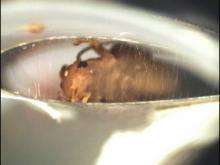
Silk is a natural protein fiber, some forms of which can be woven into textiles. The protein fiber of silk is composed mainly of fibroin and is produced by certain insect larvae to form cocoons.[1] The best-known silk is obtained from the cocoons of the larvae of the mulberry silkworm Bombyx mori reared in captivity (sericulture). The shimmering appearance of silk is due to the triangular prism-like structure of the silk fibre, which allows silk cloth to refract incoming light at different angles, thus producing different colors.
Silk is produced by several insects, but generally only the silk of moth caterpillars has been used for textile manufacturing. There has been some research into other types of silk, which differ at the molecular level.[2] Silk is mainly produced by the larvae of insects undergoing complete metamorphosis, but some insects such as webspinners and raspy crickets produce silk throughout their lives.[3] Silk production also occurs in Hymenoptera (bees, wasps, and ants), silverfish, mayflies, thrips, leafhoppers, beetles, lacewings, fleas, flies, and midges.[2] Other types of arthropod produce silk, most notably various arachnids such as spiders.
Etymology
The word silk comes from Old English sioloc, from Greek σηρικός serikos, "silken", ultimately from an Asian source (cf. Chinese si "silk", Manchurian sirghe, Mongolian sirkek).[4]
History
Wild silk

Several kinds of wild silk, which are produced by caterpillars other than the mulberry silkworm, have been known and used in China, South Asia, and Europe since ancient times. However, the scale of production was always far smaller than for cultivated silks. There are several reasons for this: first, they differ from the domesticated varieties in colour and texture and are therefore less uniform; second, cocoons gathered in the wild have usually had the pupa emerge from them before being discovered so the silk thread that makes up the cocoon has been torn into shorter lengths; and third, many wild cocoons are covered in a mineral layer that stymies attempts to reel from them long strands of silk.[5] Thus, the only way to obtain silk suitable for spinning into textiles in areas where commercial silks are not cultivated was by tedious and labor-intensive carding.
Commercial silks originate from reared silkworm pupae, which are bred to produce a white-colored silk thread with no mineral on the surface. The pupae are killed by either dipping them in boiling water before the adult moths emerge or by piercing them with a needle. These factors all contribute to the ability of the whole cocoon to be unravelled as one continuous thread, permitting a much stronger cloth to be woven from the silk. Wild silks also tend to be more difficult to dye than silk from the cultivated silkworm.[6][7] A technique known as demineralizing allows the mineral layer around the cocoon of wild silk moths to be removed,[8] leaving only variability in color as a barrier to creating a commercial silk industry based on wild silks in the parts of the world where wild silk moths thrive, such as in Africa and South America.
Genetic modification of domesticated silkworms is used to facilitate the production of more useful types of silk.[9]
China

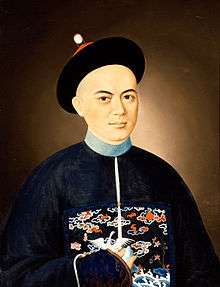
Silk fabric was first developed in ancient China.[10][11] The earliest example of silk fabric is from 3630 BC, and it was used as wrapping for the body of a child from a Yangshao site in Qingtaicun at Xingyang, Henan.[10][12]
Legend gives credit for developing silk to a Chinese empress, Leizu (Hsi-Ling-Shih, Lei-Tzu). Silks were originally reserved for the Emperors of China for their own use and gifts to others, but spread gradually through Chinese culture and trade both geographically and socially, and then to many regions of Asia. Because of its texture and lustre, silk rapidly became a popular luxury fabric in the many areas accessible to Chinese merchants. Silk was in great demand, and became a staple of pre-industrial international trade. In July 2007, archaeologists discovered intricately woven and dyed silk textiles in a tomb in Jiangxi province, dated to the Eastern Zhou Dynasty roughly 2,500 years ago.[13] Although historians have suspected a long history of a formative textile industry in ancient China, this find of silk textiles employing "complicated techniques" of weaving and dyeing provides direct evidence for silks dating before the Mawangdui-discovery and other silks dating to the Han Dynasty (202 BC-220 AD).[13]
Silk is described in a chapter on mulberry planting by Si Shengzhi of the Western Han (206 BC – 9 AD). There is a surviving calendar for silk production in an Eastern Han (25–220 AD) document. The two other known works on silk from the Han period are lost.[10] The first evidence of the long distance silk trade is the finding of silk in the hair of an Egyptian mummy of the 21st dynasty, c.1070 BC.[14] The silk trade reached as far as the Indian subcontinent, the Middle East, Europe, and North Africa. This trade was so extensive that the major set of trade routes between Europe and Asia came to be known as the Silk Road.
The Emperors of China strove to keep knowledge of sericulture secret to maintain the Chinese monopoly. Nonetheless sericulture reached Korea with technological aid from China around 200 BC, the ancient Kingdom of Khotan by AD 50,[15] and India by AD 140.[16]
In the ancient era, silk from China was the most lucrative and sought-after luxury item traded across the Eurasian continent,[17] and many civilizations, such as the ancient Persians, benefited economically from trade.[17]
- Chinese silk making process
-
.jpg)
The silkworms and mulberry leaves are placed on trays.
-
.jpg)
Twig frames for the silkworms are prepared.
-
.jpg)
The cocoons are weighed.
-
.jpg)
The cocoons are soaked and the silk is wound on spools.
-
.jpg)
The silk is woven using a loom.
India
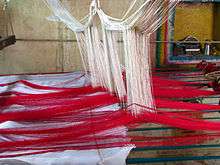
Silk has a long history in India. It is known as Resham in eastern and north India, and Pattu in southern parts of India. Recent archaeological discoveries in Harappa and Chanhu-daro suggest that sericulture, employing wild silk threads from native silkworm species, existed in South Asia during the time of the Indus Valley Civilization dating between 2450 BC and 2000 BC, while "hard and fast evidence" for silk production in China dates back to around 2570 BC.[18][19] Shelagh Vainker, a silk expert at the Ashmolean Museum in Oxford, who sees evidence for silk production in China "significantly earlier" than 2500–2000 BC, suggests, "people of the Indus civilization either harvested silkworm cocoons or traded with people who did, and that they knew a considerable amount about silk."[18]
India is the second largest producer of silk in the world after China. About 97% of the raw silk comes from five Indian states, namely, Andhra Pradesh, Karnataka, Jammu and Kashmir, Tamil Nadu and West Bengal.[20] North Bangalore, the upcoming site of a $20 million "Silk City" Ramanagara and Mysore, contribute to a majority of silk production in Karnataka.[21]
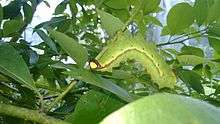
In Tamil Nadu, mulberry cultivation is concentrated in the Coimbatore, Erode, Tiruppur, Salem and Dharmapuri districts. Hyderabad, Andhra Pradesh, and Gobichettipalayam, Tamil Nadu, were the first locations to have automated silk reeling units in India.[22]
India is also the largest consumer of silk in the world. The tradition of wearing silk sarees for marriages and other auspicious ceremonies is a custom in Assam and southern parts of India. Silk is considered to be a symbol of royalty, and, historically, silk was used primarily by the upper classes. Silk garments and sarees produced in Kanchipuram, Pochampally, Dharmavaram, Mysore, Arani in the south, Banaras in the north, and Murshidabad in the east are well recognized. In the northeastern state of Assam, three different types of silk are produced, collectively called Assam silk: Muga, Eri and Pat silk. Muga, the golden silk, and Eri are produced by silkworms that are native only to Assam.
Thailand
Silk is produced year-round in Thailand by two types of silkworms, the cultured Bombycidae and wild Saturniidae. Most production is after the rice harvest in the southern and northeastern parts of the country. Women traditionally weave silk on hand looms and pass the skill on to their daughters, as weaving is considered to be a sign of maturity and eligibility for marriage. Thai silk textiles often use complicated patterns in various colours and styles. Most regions of Thailand have their own typical silks. A single thread filament is too thin to use on its own so women combine many threads to produce a thicker, usable fiber. They do this by hand-reeling the threads onto a wooden spindle to produce a uniform strand of raw silk. The process takes around 40 hours to produce a half kilogram of silk. Many local operations use a reeling machine for this task, but some silk threads are still hand-reeled. The difference is that hand-reeled threads produce three grades of silk: two fine grades that are ideal for lightweight fabrics, and a thick grade for heavier material.
The silk fabric is soaked in extremely cold water and bleached before dyeing to remove the natural yellow coloring of Thai silk yarn. To do this, skeins of silk thread are immersed in large tubs of hydrogen peroxide. Once washed and dried, the silk is woven on a traditional hand-operated loom.[23]
Bangladesh
The Rajshahi Division of northern Bangladesh is the hub of the country's silk industry. There are three types of silk produced in the region: mulberry, endi and tassar. Bengali silk was a major item of international trade for centuries. It was known as Ganges silk in medieval Europe. Bengal was the leading exporter of silk between the 16th and 19th centuries.[24]
Ancient Mediterranean

In the Odyssey, 19.233, when Odysseus, while pretending to be someone else, is questioned by Penelope about her husband's clothing, he says that he wore a shirt "gleaming like the skin of a dried onion" (varies with translations, literal translation here)[25] which could refer to the lustrous quality of silk fabric. The Roman Empire knew of and traded in silk, and Chinese silk was the most highly priced luxury good imported by them.[17] During the reign of emperor Tiberius, sumptuary laws were passed that forbade men from wearing silk garments, but these proved ineffectual.[26] Despite the popularity of silk, the secret of silk-making only reached Europe around AD 550, via the Byzantine Empire. Legend has it that monks working for the emperor Justinian I smuggled silkworm eggs to Constantinople in hollow canes from China. All top-quality looms and weavers were located inside the Great Palace complex in Constantinople, and the cloth produced was used in imperial robes or in diplomacy, as gifts to foreign dignitaries. The remainder was sold at very high prices.
Middle East
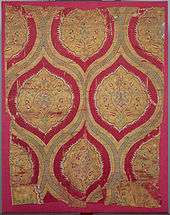
In the Torah, a scarlet cloth item called in Hebrew "sheni tola'at" שני תולעת – literally "crimson of the worm" – is described as being used in purification ceremonies, such as those following a leprosy outbreak (Leviticus 14), alongside cedar wood and hyssop (za'atar). Eminent scholar and leading medieval translator of Jewish sources and books of the Bible into Arabic, Rabbi Saadia Gaon, translates this phrase explicitly as "crimson silk" – חריר קרמז حرير قرمز.
In Islamic teachings, Muslim men are forbidden to wear silk. Many religious jurists believe the reasoning behind the prohibition lies in avoiding clothing for men that can be considered feminine or extravagant.[27] There are disputes regarding the amount of silk a fabric can consist of (e.g., whether a small decorative silk piece on a cotton caftan is permissible or not) for it to be lawful for men to wear, but the dominant opinion of most Muslim scholars is that the wearing of silk by men is forbidden. Modern attire has raised a number of issues, including, for instance, the permissibility of wearing silk neckties, which are masculine articles of clothing.
Despite injunctions against silk for men, silk has retained its popularity in the Islamic world because of its permissibility for women, and due to the presence of non-Muslim communities. The Muslim Moors brought silk with them to Spain during their conquest of the Iberian Peninsula.
Medieval and modern Europe
.jpg)
Italy was the most important producer of silk during the Medieval age. The first center to introduce silk production to Italy was the city of Catanzaro during the 11th century in the region of Calabria. The silk of Catanzaro supplied almost all of Europe and was sold in a large market fair in the port of Reggio Calabria, to Spanish, Venetian, Genovese and Dutch merchants. Catanzaro became the lace capital of the world with a large silkworm breeding facility that produced all the laces and linens used in the Vatican. The city was world-famous for its fine fabrication of silks, velvets, damasks and brocades.[28]
Another notable center was the Italian city-state of Lucca which largely financed itself through silk-production and silk-trading, beginning in the 12th century. Other Italian cities involved in silk production were Genoa, Venice and Florence.
The Silk Exchange in Valencia from the 15th century—where previously in 1348 also perxal (percale) was traded as some kind of silk—illustrates the power and wealth of one of the great Mediterranean mercantile cities.[29][30]
Silk was produced in and exported from the province of Granada, Spain, especially the Alpujarras region, until the Moriscos, whose industry it was, were expelled from Granada in 1571.[31][32]
Since the 15th century, silk production in France has been centered around the city of Lyon where many mechanic tools for mass production were first introduced in the 17th century.
James I attempted to establish silk production in England, purchasing and planting 100,000 mulberry trees, some on land adjacent to Hampton Court Palace, but they were of a species unsuited to the silk worms, and the attempt failed. In 1732 John Guardivaglio set up a silk throwing enterprise at Logwood mill in Stockport; in 1744, Burton Mill was erected in Macclesfield; and in 1753 Old Mill was built in Congleton.[33] These three towns remained the centre of the English silk throwing industry until silk throwing was replaced by silk waste spinning. British enterprise also established silk filature in Cyprus in 1928. In England in the mid-20th century, raw silk was produced at Lullingstone Castle in Kent. Silkworms were raised and reeled under the direction of Zoe Lady Hart Dyke, later moving to Ayot St Lawrence in Hertfordshire in 1956.[34]
- Medieval and modern Europe
-

Dress made from silk.
-

Bed covered with silk
-
A hundred year old pattern of silk called "Almgrensrosen"
- ^ Eric P. Nash (30 July 1995). "STYLE; Dressed to Kill". The New York Times. Retrieved 12 October 2011.
- ^ Vladimir Huzjan (July 2008). "Pokušaj otkrivanja nastanka i razvoja kravate kao riječi i odjevnoga predmeta" [The origin and development of the tie (kravata) as a word and as a garment]. Povijesni prilozi (in Croatian). Croatian Institute of History. 34 (34): 103–120. ISSN 0351-9767. Retrieved 17 October 2011.
- ^ "Silk Production in Konavle". Retrieved 22 April 2015.
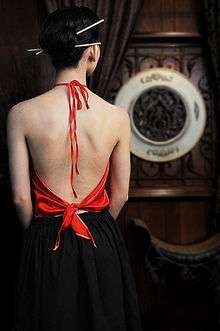
North America
King James I introduced silk-growing to the American colonies around 1619, ostensibly to discourage tobacco planting. The Shakers in Kentucky adopted the practice. In the 19th century a new attempt at a silk industry began with European-born workers in Paterson, New Jersey, and the city became a silk center in the United States. Manchester, Connecticut emerged as center of the silk industry in America from the late 19th through the mid-20th century. The Cheney Brothers Historic District showcases mills refurbished as apartments and includes nearby museums.
World War II interrupted the silk trade from Asia, and silk prices increased dramatically.[35] U.S. industry began to look for substitutes, which led to the use of synthetics such as nylon. Synthetic silks have also been made from lyocell, a type of cellulose fiber, and are often difficult to distinguish from real silk (see spider silk for more on synthetic silks).
Malaysia
In Terengganu, which is now part of Malaysia, a second generation of silkworm was being imported as early as 1764 for the country's silk textile industry, especially songket.[36] However, since the 1980s, Malaysia is no longer engaged in sericulture but does plant mulberry trees.
Vietnam
In Vietnamese legend, silk appeared in the sixth dynasty of Hùng Vương.
Production process
The process of silk production is known as sericulture. The entire production process of silk can be divided into several steps which are typically handled by different entities. Extracting raw silk starts by cultivating the silkworms on mulberry leaves. Once the worms start pupating in their cocoons, these are dissolved in boiling water in order for individual long fibres to be extracted and fed into the spinning reel.[37]
The environmental impact of silk production is potentially large when compared with other natural fibers. A life cycle assessment of Indian silk production shows that the production process has a large carbon and water footprint, mainly due to the fact that it is an animal-derived fiber and more inputs such as fertilizer and water are needed per unit of fiber produced.[38]
Properties

Physical properties
Silk fibers from the Bombyx mori silkworm have a triangular cross section with rounded corners, 5–10 μm wide. The fibroin-heavy chain is composed mostly of beta-sheets, due to a 59-mer amino acid repeat sequence with some variations.[39] The flat surfaces of the fibrils reflect light at many angles, giving silk a natural sheen. The cross-section from other silkworms can vary in shape and diameter: crescent-like for Anaphe and elongated wedge for tussah. Silkworm fibers are naturally extruded from two silkworm glands as a pair of primary filaments (brin), which are stuck together, with sericin proteins that act like glue, to form a bave. Bave diameters for tussah silk can reach 65 μm. See cited reference for cross-sectional SEM photographs.[40]
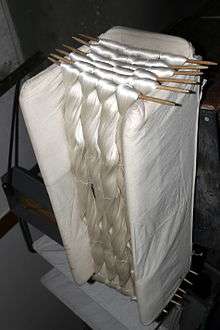
Silk has a smooth, soft texture that is not slippery, unlike many synthetic fibers.
Silk is one of the strongest natural fibers, but it loses up to 20% of its strength when wet. It has a good moisture regain of 11%. Its elasticity is moderate to poor: if elongated even a small amount, it remains stretched. It can be weakened if exposed to too much sunlight. It may also be attacked by insects, especially if left dirty.
One example of the durable nature of silk over other fabrics is demonstrated by the recovery in 1840 of silk garments from a wreck of 1782: 'The most durable article found has been silk; for besides pieces of cloaks and lace, a pair of black satin breeches, and a large satin waistcoat with flaps, were got up, of which the silk was perfect, but the lining entirely gone ... from the thread giving way ... No articles of dress of woollen cloth have yet been found.'[41]
Silk is a poor conductor of electricity and thus susceptible to static cling.
Unwashed silk chiffon may shrink up to 8% due to a relaxation of the fiber macrostructure, so silk should either be washed prior to garment construction, or dry cleaned. Dry cleaning may still shrink the chiffon up to 4%. Occasionally, this shrinkage can be reversed by a gentle steaming with a press cloth. There is almost no gradual shrinkage nor shrinkage due to molecular-level deformation.
Natural and synthetic silk is known to manifest piezoelectric properties in proteins, probably due to its molecular structure.[42]
Silkworm silk was used as the standard for the denier, a measurement of linear density in fibers. Silkworm silk therefore has a linear density of approximately 1 den, or 1.1 dtex.
| Comparison of silk fibers[43] | Linear density (dtex) | Diameter (μm) | Coeff. variation |
|---|---|---|---|
| Moth: Bombyx mori | 1.17 | 12.9 | 24.8% |
| Spider: Argiope aurentia | 0.14 | 3.57 | 14.8% |
Chemical properties
Silk emitted by the silkworm consists of two main proteins, sericin and fibroin, fibroin being the structural center of the silk, and serecin being the sticky material surrounding it. Fibroin is made up of the amino acids Gly-Ser-Gly-Ala-Gly-Ala and forms beta pleated sheets. Hydrogen bonds form between chains, and side chains form above and below the plane of the hydrogen bond network.
The high proportion (50%) of glycine allows tight packing. This is because glycine's R group is only a hydrogen and so is not as sterically constrained. The addition of alanine and serine makes the fibres strong and resistant to breaking. This tensile strength is due to the many interceded hydrogen bonds, and when stretched the force is applied to these numerous bonds and they do not break.
Silk is resistant to most mineral acids, except for sulfuric acid, which dissolves it. It is yellowed by perspiration. Chlorine bleach will also destroy silk fabrics.
Uses
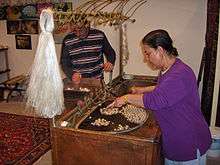
Silk's absorbency makes it comfortable to wear in warm weather and while active. Its low conductivity keeps warm air close to the skin during cold weather. It is often used for clothing such as shirts, ties, blouses, formal dresses, high fashion clothes, lining, lingerie, pajamas, robes, dress suits, sun dresses and Eastern folk costumes. For practical use, silk is excellent as clothing that protects from many biting insects that would ordinarily pierce clothing, such as mosquitoes and horseflies. Silk's attractive lustre and drape makes it suitable for many furnishing applications. It is used for upholstery, wall coverings, window treatments (if blended with another fiber), rugs, bedding and wall hangings. While on the decline now, due to artificial fibers, silk has had many industrial and commercial uses, such as in parachutes, bicycle tires, comforter filling and artillery gunpowder bags.
Fabrics that are often made from silk include charmeuse, habutai, chiffon, taffeta, crepe de chine, dupioni, noil, tussah, and shantung, among others.
A special manufacturing process removes the outer irritant sericin coating of the silk, which makes it suitable as non-absorbable surgical sutures. This process has also recently led to the introduction of specialist silk underclothing for people with eczema where it can significantly reduce it.[44][45] New uses and manufacturing techniques have been found for silk for making everything from disposable cups to drug delivery systems and holograms.[46] To produce 1 kg of silk, 104 kg of mulberry leaves must be eaten by 3000 silkworms. It takes about 5000 silkworms to make a pure silk kimono.[47]:104 The production of silk is called sericulture. The major silk producers are China (54%) and India (14%).[48] Other statistics:[49]
| Top Ten Cocoons (Reelable) Producers — 2005 | ||||
|---|---|---|---|---|
| Country | Production (Int $1000) | Footnote | Production (1000 kg) | Footnote |
| 978,013 | C | 290,003 | F | |
| 259,679 | C | 77,000 | F | |
| 57,332 | C | 17,000 | F | |
| 37,097 | C | 11,000 | F | |
| 20,235 | C | 6,088 | F | |
| 16,862 | C | 5,000 | F | |
| 10,117 | C | 3,000 | F | |
| 5,059 | C | 1,500 | F | |
| 3,372 | C | 1,000 | F | |
| 2,023 | C | 600 | F | |
| No symbol = official figure, F = FAO estimate,*= Unofficial figure, C = Calculated figure; Production in Int $1000 have been calculated based on 1999–2001 international prices | ||||
Cultivation
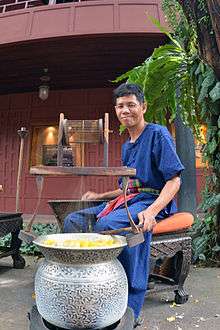
Silk moths lay eggs on specially prepared paper. The eggs hatch and the caterpillars (silkworms) are fed fresh mulberry leaves. After about 35 days and 4 moltings, the caterpillars are 10,000 times heavier than when hatched and are ready to begin spinning a cocoon. A straw frame is placed over the tray of caterpillars, and each caterpillar begins spinning a cocoon by moving its head in a pattern. Two glands produce liquid silk and force it through openings in the head called spinnerets. Liquid silk is coated in sericin, a water-soluble protective gum, and solidifies on contact with the air. Within 2–3 days, the caterpillar spins about 1 mile of filament and is completely encased in a cocoon. The silk farmers then heat the cocoons to kill them, leaving some to metamorphose into moths to breed the next generation of caterpillars. Harvested cocoons are then soaked in boiling water to soften the sericin holding the silk fibers together in a cocoon shape. The fibers are then unwound to produce a continuous thread. Since a single thread is too fine and fragile for commercial use, anywhere from three to ten strands are spun together to form a single thread of silk.[50]
Animal rights
As the process of harvesting the silk from the cocoon kills the larvae by boiling them, sericulture has been criticized by animal welfare and rights activists.[51] Mohandas Gandhi was critical of silk production based on the Ahimsa philosophy which led to promotion of cotton and Ahimsa silk, a type of wild silk made from the cocoons of wild and semi-wild silk moths.[52] Since silk cultivation kills silkworms, possibly painfully,[53] People for the Ethical Treatment of Animals (PETA) urges people not to buy silk items.[54]
See also
References
Citations
- ↑ "Silk". The Free Dictionary By Farlex. Retrieved 2012-05-23.
- 1 2 Sutherland TD, Young JH, Weisman S, Hayashi CY, Merritt DJ (2010). "Insect silk: one name, many materials". Annual Review of Entomology. 55: 171–88. doi:10.1146/annurev-ento-112408-085401. PMID 19728833.
- ↑ Walker AA, Weisman S, Church JS, Merritt DJ, Mudie ST, Sutherland TD (2012). "Silk from Crickets: A New Twist on Spinning". PLoS ONE. 7 (2): e30408. doi:10.1371/journal.pone.0030408. PMC 3280245
 . PMID 22355311.
. PMID 22355311. - ↑ "Silk". Etymonline. Retrieved 2012-08-27.
- ↑ Sindya N. Bhanoo (20 May 2011). "Silk Production Takes a Walk on the Wild Side". New York Times. Retrieved 26 May 2011.
- ↑ Hill (2004). Appendix E.
- ↑ Hill (2009), "Appendix C: Wild Silks," pp.477–480.
- ↑ Gheysens, T; Collins, A; Raina, S; Vollrath, F; Knight, D (2011). "Demineralization enables reeling of Wild Silkmoth cocoons". Biomacromolecules. American Chemical Society. 12 (6): 2257–66. doi:10.1021/bm2003362. PMID 21491856.
- ↑ Kojima, K.; Kuwana, Y.; Sezutsu, H.; Kobayashi, I.; Uchino, K.; Tamura, T.; Tamada, Y. (2007). "A new method for the modification of fibroin heavy chain protein in the transgenic silkworm". Bioscience, Biotechnology, and Biochemistry. 71 (12): 2943–2951. doi:10.1271/bbb.70353. PMID 18071257.
- 1 2 3 Vainker, Shelagh (2004). Chinese Silk: A Cultural History. Rutgers University Press. pp. 20, 17. ISBN 0813534461.
- ↑ "Silk: History". Columbia Encyclopedia Sixth Edition.
- ↑ "Textile Exhibition: Introduction". Asian art.
- 1 2 "Chinese archaeologists make ground-breaking textile discovery in 2,500-year-old tomb". People's Daily Online. Retrieved 26 August 2007.
- ↑ Lubec, G.; J. Holaubek; C. Feldl; B. Lubec; E. Strouhal (4 March 1993). "Use of silk in ancient Egypt". Nature. 362 (6415): 25. doi:10.1038/362025b0. (also available here )
- ↑ Hill, John E. (2009) Through the Jade Gate to Rome: A Study of the Silk Routes during the Later Han Dynasty, 1st to 2nd Centuries CE. BookSurge, Charleston, South Carolina. ISBN 978-1-4392-2134-1. Appendix A: "Introduction of Silk Cultivation to Khotan in the 1st Century CE," pp. 466–467.
- ↑ "History of Sericulture" (PDF). Government of Andhra Pradesh (India) – Department of Sericulture. Retrieved 7 November 2010.
- 1 2 3 Garthwaite, Gene Ralph (2005). The Persians. Oxford & Carlton: Blackwell Publishing, Ltd. p. 78. ISBN 1-55786-860-3.
- 1 2 Abbott, Phill. "Rethinking silk's origins : Nature News". Nature.com. Retrieved 2013-11-09.
- ↑ Good, I.L.; Kenoyer, J.M.; Meadow, R.H. (2009). "New evidence for early silk in the Indus civilization". Archaeometry. 50 (3): 457. doi:10.1111/j.1475-4754.2008.00454.x.
- ↑ Tn Sericulture. Tn Sericulture (2014-06-30). Retrieved on 2016-08-02.
- ↑ "Silk city to come up near B'lore". Deccan Herald. Retrieved 22 April 2015.
- ↑ "Tamil Nadu News : Tamil Nadu's first automatic silk reeling unit opened". The Hindu. 2008-08-24. Retrieved 2013-11-09.
- ↑ About Thai silk from World of Thai Silk (commercial)
- ↑ Silk – Banglapedia. En.banglapedia.org (2015-03-10). Retrieved on 2016-08-02.
- ↑ Odyssey 19 233–234: τὸν δὲ χιτῶν' ἐνόησα περὶ χροῒ σιγαλόεντα, οἷόν τε κρομύοιο λοπὸν κάτα ἰσχαλέοιο· = "And I [= Odysseus
- ↑ Tacitus. Annals. ISBN 0-521-31543-3.
- ↑ "Silk: Why It Is Haram for Men". 23 September 2003. Archived from the original on 2 March 2007. Retrieved 6 January 2007.
- ↑ "Office of Tourism – Italy – Calabria, Catanzaro".
- ↑ "La Lonja de la Seda de Valencia – UNESCO World Heritage Centre". Whc.unesco.org. Retrieved 2011-04-10.
- ↑ Diccionari Aguiló: materials lexicogràfics / aplegats per Marià Aguiló i Fuster; revisats i publicats sota la cura de Pompeu Fabra i Manuel de Montoliu, page 134, Institut d'Estudis Catalans, Barcelona 1929.
- ↑ José Luis Delgado, "La seda de Granada era la mejor", Granada Hoy, October 8, 2012, http://www.granadahoy.com/article/granada/1370023/la/seda/granada/era/la/mejor.html, retrieved 2014-08-18
- ↑ Aurora Intxausti, "La Alpujarra poseía 4.000 telares de seda antes de la expulsión de los moriscos", El País, May 1, 2013, http://cultura.elpais.com/cultura/2013/04/29/actualidad/1367255987_780232.html, retrieved 2014-08-14.
- ↑ Callandine 1993
- ↑ "Lullingstone Silk Farm". www.lullingstonecastle.co.uk. Retrieved 29 September 2016.
- ↑ Weatherford, D (2009). American Women During World War II: An Encyclopedia. Routledge. p. 97. ISBN 0415994756.
- ↑ The Malayhandloom weavers:a study of the rise and decline of traditional. Books.google.com.my. Retrieved 2013-11-09.
- ↑ Bezzina, Neville. "Silk Production Process".
- ↑ Astudillo, Miguel F.; Thalwitz, Gunnar; Vollrath, Fritz (October 2014). "Life cycle assessment of Indian silk". Journal of Cleaner Production. 81: 158–167. doi:10.1016/j.jclepro.2014.06.007.
- ↑ "Handbook of Fiber Chemistry", Menachem Lewin, Editor, 3rd ed., 2006, CRC press, ISBN 0-8247-2565-4
- ↑ "Handbook of Fiber Chemistry", Menachem Lewin, Editor, 2nd ed.,1998, Marcel Dekker, pp. 438–441, ISBN 0-8247-9471-0
- ↑ The Times, London, article CS117993292, dated 12 Oct 1840, retrieved 30 Apr 2004.
- ↑ "Piezoelectricity in Natural and Synthetic Silks" (PDF). Retrieved 28 April 2010.
- ↑ Frank K. Ko; Sueo Kawabata; Mari Inoue; Masako Niwa. "Engineering Properties of Spider Silk" (PDF). Retrieved 9 July 2010.
- ↑ Ricci, G et al. "Clinical Effectiveness of a Silk Fabric in the Treatment of Atopic Dermatitis", British Journal of Dermatology 2004. Issue 150. Pages 127 – 131
- ↑ Treatment. Senti. G. et al. "Antimicrobial Silk Clothing in the Treatment of Atopic Dermatitis Proves Comparable to Topical Corticosteroid" Department of Dermatology. Zurich Switzerland. Published in Dermatology 2006. 213:228 – 233
- ↑ Fiorenzo Omenetto. "Fiorenzo Omenetto: Silk, the ancient material of the future - Talk Video - TED.com". Retrieved 22 April 2015.
- ↑ Fritz, Anne and Cant, Jennifer (1986). Consumer Textiles. Oxford University Press Australia. Reprint 1987. ISBN 0-19-554647-4.
- ↑ "Mulberry Silk – Textile Fibres – Handloom Textiles | Handwoven Fabrics | Natural Fabrics | Cotton clothes in Chennai". Brasstacksmadras.com. Retrieved 2013-11-09.
- ↑ "Statistics".
- ↑ Carrie Gleason: The Biography of Silk, page 12. Crabtree Publishing Company 2007.
- ↑ Stancati, Margherita (4 Jan 2011). "Taking the Violence Out of Silk". Wall Street Journal. Retrieved 22 January 2015.
- ↑ "Mahatma Gandhi: 100 years", 1968, p. 349
- ↑ Geer, Abigail (2013-06-21). "The Dark and Disturbing World of Silk". Care2. Retrieved 2014-01-23.
[silkworms] have the capacity to feel and the right to live free from pain and suffering.
- ↑ "Down and Silk: Birds and Insects Exploited for Feathers and Fabric". PETA. Retrieved 2014-01-23.
Silk Production Causes Painful Death for Insects
Sources
- Callandine, Anthony (1993). "Lombe's Mill: An Exercise in reconstruction". Industrial Archaeology Review. Maney Publishing. XVI (1). ISSN 0309-0728.
- Good, Irene. 1995. "On the question of silk in pre-Han Eurasia" Antiquity Vol. 69, Number 266, December 1995, pp. 959–968
- Hill, John E. 2004. The Peoples of the West from the Weilüe 魏略 by Yu Huan 魚豢: A Third Century Chinese Account Composed between 239 and 265 AD. Draft annotated English translation. Appendix E.
- Kuhn, Dieter. 1995. "Silk Weaving in Ancient China: From Geometric Figures to Patterns of Pictorial Likeness." Chinese Science 12 (1995): pp. 77–114.
- Liu, Xinru (1996). Silk and Religion: An Exploration of Material Life and the Thought of People, AD 600–1200. Oxford University Press.
- Liu, Xinru (2010). The Silk Road in World History. Oxford University Press. ISBN 978-0-19-516174-8; ISBN 978-0-19-533810-2 (pbk).
- Rayner, Hollins (1903). Silk throwing and waste silk spinning. Scott, Greenwood, Van Nostrand.
- Sung, Ying-Hsing. 1637. Chinese Technology in the Seventeenth Century – T'ien-kung K'ai-wu. Translated and annotated by E-tu Zen Sun and Shiou-chuan Sun. Pennsylvania State University Press, 1966. Reprint: Dover, 1997. Chap. 2. Clothing materials.
- Kadolph, Sara J. Textiles. 10th ed. Upper Saddle River: Pearson Prentice Hall, 2007. 76–81.
- Ricci, G, et al. "Clinical Effectiveness of a Silk Fabric in the Treatment of Atopic Dermatitis", British Journal of Dermatology (2004) Issue 150. Pages 127 – 131
External links
| Look up silk in Wiktionary, the free dictionary. |
| Wikimedia Commons has media related to Silk. |
- References to silk by Roman and Byzantine writers
- A series of maps depicting the global trade in silk
- History of traditional silk in martial arts uniforms
- Raising silkworms in classrooms for educational purposes (with photos)
- New thread in fabric of insect silks|physorg.com
- Fiorenzo Omenetto: Silk, the ancient material of the future
.svg.png)




.svg.png)